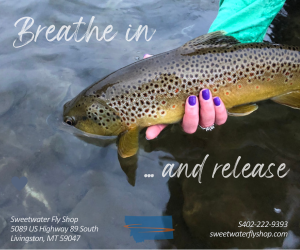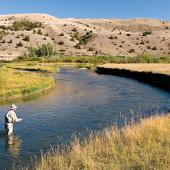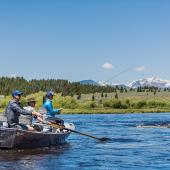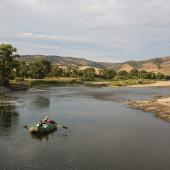The Untied Angler
To tie, or not to tie?
I don’t milk cows. Nor do I concoct ski wax from beeswax or laminate the rubber soles of my own running shoes. I’ve yet to mill the parts and assemble a 20-gauge or build a fly rod from a skinny length of shiny graphite. None of those things seem to matter. Not once has a fellow cross-country skier sidled up to me and asked, “Do you blend your own wax?” Fellow runners don’t look to see if one another’s shoes are homemade. Their eyes tend to rove elsewhere, like the back of the running shorts on the girl ahead whose flimsy nylon is imprinted with the words: “Since you’re behind, how’s mine?” Runners are a singular crowd. It doesn’t matter who made your shoes, just how fast you cover the 3.1 miles of a local 5k.
So what’s the big deal with tying your own flies? Once, on a nonstop flight from Denver to Boston, the smartly-attired management consultant in the seat next to me inquired about my occupation.
“I’m a writer,” I tell her.
“What do you write?”
“Magazine articles mostly, and some books.”
“About what?”
“Big-game hunting. Wildlife. Fly fishing.”
At the words “fly fishing,” her svelte legs draped in lacy stockings unfolded and she leaned slightly in my direction. For once, the announcement to “Sit back, relax, and enjoy the flight,” seemed to hold some promise.
“Ooh, that’s SO interesting.” Her blue eyes smiled at mine. “Do you tie your own flies?”
“Uh, no.”
With a dismissive shrug she burrowed back into a copy of Money magazine. I wanted to point out that the publisher didn’t produce the pulp for the paper, but it seemed senseless. Hand your kids prefabricated burgers from McDonald’s and you’re a hero. Slip a dozen store-bought roses into a vase for your significant other and you’re romantic. Buy flies and you’re a loser.
For several years after my introduction to the sport, I fretted over this moral deficiency. The arguments advocating a tying addiction seemed incontrovertible. Tiers have more flexibility and success in matching local hatches. Hand-tied flies are better than those produced by commercial operations. They’re cheaper. Tying flies is a blissfully pleasant way to while away the long evenings of winter.
Slip a dozen store-bought roses into a vase for your significant other and you’re romantic. Buy flies and you’re a loser.
But the first crack in the tiers’ smug case appeared quite quickly in relation to the latter claim. I have a beautiful, affectionate sweetheart, an over-stuffed leather couch, a 75-inch 4K television, and high-speed internet. Beer, white wine, and leftover key lime pie reside in the refrigerator. Explain again this nonsense regarding the appeal of plopping your behind on a hard stool in front of a bench and straining your eyes to secure a concoction of fuzz and feathers onto a #22 hook, only to find you’ve mistakenly wound an olive pattern with scarlet dubbing?
Intent on catching more fish, I read a few books and studied magazine articles about fly fishing. Many of them were hopelessly boring and technical treatises about tying flies, written by anglers so pathetic to stew about miniscule differences in fly size and minor variations in the hues of tying materials. After devoting 2,000 words to explicate the intricacies of local entomology and explain how excruciating it is to produce a worthy fly, the tomes invariably ended with a caveat. Put a fly that reasonably matches the bugs the trout are eating on the rounded snout of a robust brownie, and it’ll likely take a chomp at it. Somehow, my neural apparatus easily forged connections reinforcing the logic of the “presentation trumps pattern” disclaimers. The whys and hows of the local pattern, best fished on cloudy afternoons the third week of November on a specific segment of the Gallatin, simply disappeared into the internal labyrinth of a thick skull.
At elk camp one autumn, a white-headed uncle confided in me that his son, a first-cousin 15 years my junior, was struggling with some maladaptive attitudes. First and foremost, his errant child was possessed of a “millionaire’s taste on a pauper’s budget,” shorthand for wondering why the heck a youth eking a year-round living as a seasonal employee of the U.S. Forest Service had recently signed a small mortgage on a BMW. Maladaptive behavior? Anyone who can live the high life on a low-life budget has my undying respect.
As it turned out, my cousin’s BMW was a battered sedan that had seen over a decade of abuse at the hands of a succession of owners. Its most salient features, my uncle explained, were the copious clouds of blue haze emitted from the tailpipe and a trunk lid that occasionally popped open for no reason whatsoever. The son of my father’s brother wasn’t really living the high life on a dime, and I would soon discover the savings from fly-tying wouldn’t put me in an expensive imported automobile either.
Teetering on the brink of buying a fly-tying starter kit from a large, mail-order outfit with numerous options, I decided to solicit the advice of a knowledgeable member of the fraternity. As luck would have it, my first call to a friend, editor, and bespectacled angler—who never answers email or responds to voicemail or texts—connected on the first ring. Explaining my predicament, outlining in careful detail the contents of the various kits, I was mildly insulted when my mentor abruptly butted into my descriptions.
“Whoa, whoa, whoa,” he ordered bossily, though I actually shut up on the first command for silence. “If you think you’re really going to save money and make better flies, forget it.”
Puzzled, I challenged his authority in the face of all the fly-fishy experts and the general population.
“Look,” he explained patiently, as if informing a four-year-old inventor why attaching a steering wheel to the upturned handle of a red wagon won’t make it more manageable on the steep, twisting driveway that has already broken several limbs on his older siblings who attempted similar modifications on a toboggan. “In addition to that $200 kit, you’d better have the cash for at least that much more in tying materials. The first flies you make will be crappy imitations of something totally boring, like a black woolly bugger. By the time you can tie something that’s better than the store models, you might be into it for a thousand bucks. Those foreign fellows cranking out flies in a factory may have never seen so much as pictures of a trout, but when they whip out over a hundred beadhead Prince nymphs in a day they get pretty damn good at it.”
“So why do you tie?” I asked
After a long silence the speaker on my cell phone again crackled with the sound of his voice, lower now, and tinged with pain.
“The wife and I really don’t get along that well anymore… it gives me space. I do save a little scratch on complicated patterns and big stuff like bass flies. But if you value your love life and eyes, keep buying flies.”
Re-focusing my gaze on the stewardess who was politely inquiring whether I’d like my coffee black or with cream, it struck me that the blonde just might be a lunatic floozy living on a trust-fund who jets around the country for fun, posing as a successful businessperson. Until I find a reason more compelling than impressing the uninformed, my angling life shall remain happily untied.












